Outsourcing software development has become common practice, and the number of software development vendors worldwide is constantly growing. According to Statista, the value of IT services that companies delegate to external suppliers may exceed $413.72 billion by the end of 2021. By comparison, in 2018 the market was projected to be $378.1 billion. On the one hand, this increasing demand results in the birth of more outsourcing vendors, while on the other hand, it contributes to market overheating and makes it difficult to find a reliable software development partner.
In this ultimate guide, we’ll explain the process of choosing an outsourcing provider, focusing on the value it can provide to your business. We’ll look at common and non-trivial criteria for choosing a software development company and explain when you may need to create a vendor list. Last but not least, we’ll supply real examples from some of the domains we work in at Yalantis. Fasten your seatbelts and let’s get started!
What the process of choosing an outsourcing partner looks like
Selecting your software development vendor is a complex procedure, which is why we’ll start with generic considerations and then look at specific points to consider in each business case.
At Yalantis, we define six stages of choosing an outsourcing partner.

Although only one of these stages is literally called “evaluation,” in reality, evaluation is something that happens during each part of the vendor selection process. As an executive, you want to:
- check if all of your requirements are met
- measure a vendor’s domain expertise
- assess how you feel about communication with a potential partner
- and so on
To help you define the key areas in evaluating potential partners, remain objective, and never get lost in the variety of options available in the software development market, we recommend conducting success checkups. Ask yourself the questions below as you progress through the vendor selection stages.
- Requirements. At this stage, you usually form expectations on cooperation with a software outsourcing vendor and define tasks to delegate. Start by coming up with priorities, defining taboos, and choosing criteria to stick to as you search for a partner.

- Research. Once you decide on the goals you strive to achieve with outsourcing and understand how to measure your success in this endeavor, you can proceed to studying the market. Usually, this stage includes identifying potential candidates by googling and browsing various ranking services.
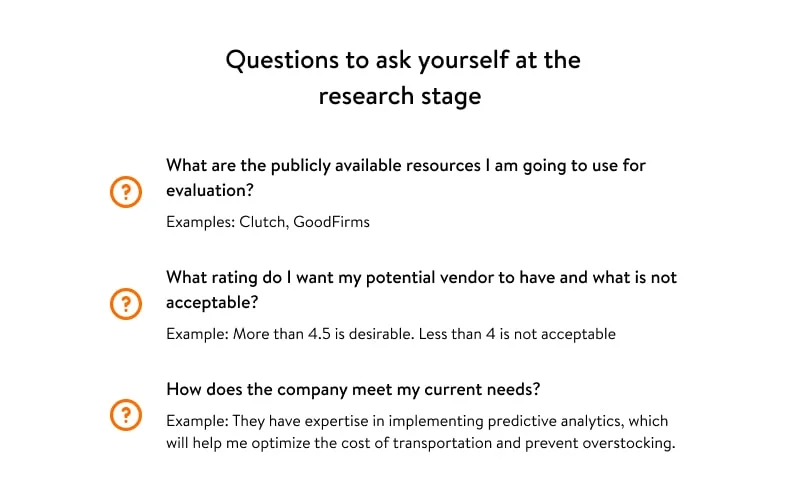
- The request for proposal (RFP) and analysis stages both require maximal involvement in the evaluation process and require you to keep your head cool. While forming an RFP literally means describing your business and specifying your requirements and market aims, processing the information you receive seems a more challenging task. During these two stages, you need to find ways to objectively assess a vendor’s expertise. During these two stages, you need to find ways to objectively assess a vendor’s expertise. Best practices at these stages include identifying existing and past clients, asking them about their experience with a company, and exploring testimonials. We recommend coming up with a list of doubts and questions and initiating an open dialogue with potential vendors.
- Evaluation and decision. Conducting Q&A sessions with your candidates is a common method of evaluating software development partners. While prior to the research, analysis, and RFP stages you may have had a general understanding of each company’s ways of dealing with your project, now you should find out more information about each of your potential outsourcing partners. Figure out how exactly a vendor is going to address your requirements, ask about details of the software development process, and assess the ease of communication. During these stages, it’s time to address all your questions with potential outsourcing vendors. After that, you can ask yourself some questions to determine how you feel about each of your candidates and make your choice.
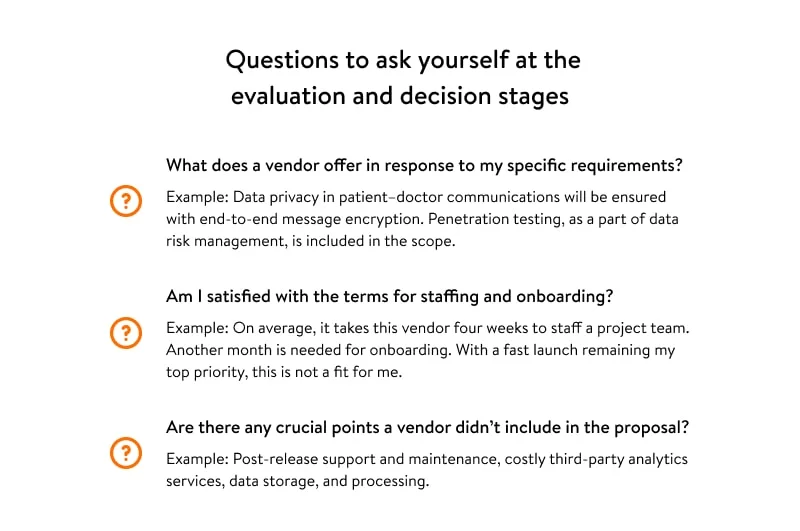
Read also: How Do We Deal with the App Development Process at Yalantis?
These stages and questions may shift depending on your perception of the evaluation process and the course suggested by potential vendors. At the same time, understanding the stages of choosing a software development partner is necessary so you can approach vendor selection in a holistic way.
What is a vendor list, when do you need one, and how should you use it for evaluation?
You might consider creating a list of potential vendors if your project has several stakeholders and not all of them are personally communicating with those vendors. The aim of such a list is usually to align stakeholders’ expectations in order to find a match that satisfies all stakeholders.
Let’s say there are four other stakeholders (besides you) who are involved in choosing a software development company. In this case, one stakeholder should be conducting initial research and selecting the 20 or so best vendors that fit your requirements. The same stakeholder should be responsible for the preliminary screening of candidates and filtering them according to rates, location, and other high-level criteria. The second stakeholder, let’s say a C-level executive or the vice president, can then step in to perform a deeper screening applying different criteria.
As you proceed to the next evaluation stages and ask yourself more in-depth questions, there remain fewer candidates. When you outline the three leaders, you may validate their candidacies with the board of directors to further make a consolidated decision and choose one software development partner.
How to choose a software provider based on your needs
Some business needs are fairly universal, while others vary depending on the domain in which you operate, and the type of product executive you are. You should take into account all needs — generic and domain-specific, objective and subjective — to find a perfect match.
Basic criteria to evaluate an IT service provider
An objective evaluation usually involves defining the criteria for choosing a software development company and following them until you find a company that meets all your essential business needs. The basic criteria most product owners choose for evaluating software providers usually include:
- Technical expertise. This is one of the most crucial factors to consider when evaluating a software development partner. Evaluating technical expertise usually includes checking if a company can offer the required technology stack as well as assessing its code quality, approach towards technological innovations, and ability to develop sophisticated software solutions like IoT systems. Our clients commonly request expertise in cloud development and consulting services, big data and analytics, and ensuring the stability of existing IT systems under high loads.
Read also: Preventive maintenance IoT expertise - Domain expertise. The main benefit of working with domain-dedicated experts is the ability to ramp up your team with subject matter experts. As a result, you can optimize your product delivery terms and create a high-quality software product. Having deep and diverse expertise in supply chain management, healthcare, and communication, we understand the role field experience plays in vendor selection and compliance with domain-specific requirements.
- Company maturity helps in selecting a reliable outsourcing partner. Maturity includes the time a company has been in the market, its growth, and its evolution. The number of successful product releases and loyal clients determines how stable your potential vendor is. The results of previous partnerships are often highlighted in case studies published on a company’s website.
- Pricing. Rates of your potential vendors are usually available on Clutch, GoodFirms, Upwork, or other ranking platforms. You can also request a quote directly on a vendor’s website. At Yalantis, we opt for the Request for Proposal (RFP) procedure. This approach is far more effective at allowing you to understand the potential of each IT service provider, as it helps your potential vendors to get a deeper understanding of your business and requires them to suggest solutions in response to your specific needs. On the contrary, if a vendor rushes to give you numbers, they demonstrate a superficial understanding of and attitude towards your goals and requirements.
- Clients and references. To identify an outsourcing provider’s focus, it’s worth checking what types of clients the provider works with. These may be enterprises, niche businesses, other software development companies, or IT consultants. Apart from checking out profiles of potential vendors on rating platforms, organizations may prefer reviewing testimonials on the corporate website. Linkedin is also a good place to look for clients’ feedback as well as to find useful contacts who could share their experience of working with a vendor.
- Cooperation models. Usually, the choice of cooperation model depends on the project duration and the client’s involvement in the development process. Among the most common models are resource-based and project-based. Major cooperation models we offer at Yalantis are Time and Materials, Fixed Price, Managed Team, and Managed Product.
- Vendor location. Choosing an outsourcing destination is another important component of successful cooperation. It’s worth evaluating your partner’s geographic location and level of digital adoption, the quantity and quality of talents available in the partner’s local market, laws and regulations on outsourcing in the partner’s jurisdiction, cultural differences, possible language barriers, and the business environment in the partner’s country. Considering the saturation of the IT market in the US and India, Eastern Europe and Ukraine specifically are promising destinations, providing quality talents at an affordable price. DesignRush, a popular B2B marketplace, regularly analyses top-performing software development companies by country and skillset. Recently, Yalantis has been recognized as one of the Top 10 Software Development Companies in Ukraine by DesignRush.
- Cybersecurity. Compliance with industry standards and regulations makes your software competitive and stable in response to any vulnerabilities. To decrease cyber protection risks and get a secure end product, make sure cyber security considerations are embedded in the entire software development process, starting from requirements elicitation and continuing through secure post-release support.
These basic criteria can be used for evaluating any software outsourcing provider. However, there are more things you might want to consider before giving the green light to future cooperation.
Non-trivial criteria to evaluate an IT service provider
While criteria like domain expertise, tech stack, rates, and location are typical for early stages of evaluation, further stages may provoke additional questions about your potential vendors. Here are some non-trivial things you might want to consider.
- Technological agility. It’s important to select a vendor who can realize your desires to implement a certain technology stack, use their expertise and experience to suggest the best possible technology options, and be agile if anything on the tech side needs to be changed or can be improved. This means that if no experts in a certain technology are available, your vendor should make an effort to find, train, and onboard them. Or if your vendor has never used a particular technology but sees it as beneficial for your project, they should take on the responsibility of mastering it.
- Determination for long-term cooperation is an indicator of your vendor’s reliability. To evaluate a company’s loyalty and dedication to its customers, it’s often enough to check the number of long-term partnerships and the stories behind them. At Yalantis, we especially value clients who stay with us for years, such as Healthfully and Truhoo.
- Stable company growth contributes to a company’s maturity and credibility. What deserves special attention are the dynamics shown in crises and turbulent times. The coronavirus pandemic has pointed to the need for an adaptive approach in changing circumstances and highlighted the progress shown by market leaders during the pandemic. For example, while some outsourcing vendors have still been experiencing massive layoffs this year, the Yalantis team has grown by 66 percent in 2021.
- Common social values. Sharing values and ideas is another criteria for making your partnership strong. Preaching similar philosophy, often helps us initiate long-lasting relationships with large corporations like, for instance, Toyota Tsusho. When evaluating software development partners, take the time to delve into how their employees spend their leisure time, their social lives, team spirit, the corporate culture, and whatever else is important to you. Ask about a company’s attitude towards politics, ecological challenges, and sexual minorities. For instance, organizations working with Yalantis often note the gender diversity of our management and our contributions to local IT education.
At this point, we are done with common and non-trivial criteria for evaluating your potential software development providers. The domain in which you operate will shape your entire vendor selection strategy and often dictates the majority of evaluation criteria.
Domain-specific needs and ways to address them
Below, we’ll provide some examples of domain-specific needs and ways to address them based on our experience working in these domains.
Logistics
To make the most of logistics software development, it’s extremely important to choose a domain-experienced outsourcing partner. For a team that is familiar with supply chain management, for instance, it will not take long to come up with technological solutions that address data management and quality control challenges.
- Warehouse automation. Automating warehouse operations often includes route optimization, load planning, and delivery and order management. To evaluate if a potential vendor can provide technical solutions for each of these tasks, check their previous experience digitizing manual processes and building custom modules for warehouses and 3PL or 4PL logistics providers. If you’re using or plan to use any third-party systems for transportation or resource management, figure out how they will be integrated with your solution.
- Visibility. Keeping track of orders, shipments, and payments is something most organizations strive to achieve with a logistics management system. It’s of special value if the system is used not just with customers but also with stakeholders and brokers. To check the competence of potential vendors, make sure the solutions they suggest include ways of predicting delays and overstocking, ask them to suggest analytics and reporting capabilities, and make sure they can provide a standardized view of your data.
- Interoperability and scalability. Building a scalable system that is easy to modify is an essential part of the B2B concept. In logistics, for example, interoperability and scalability can be achieved through building a multi-tenant architecture and facilitating cloud solutions to ensure the system is flexible and can be changed rapidly.
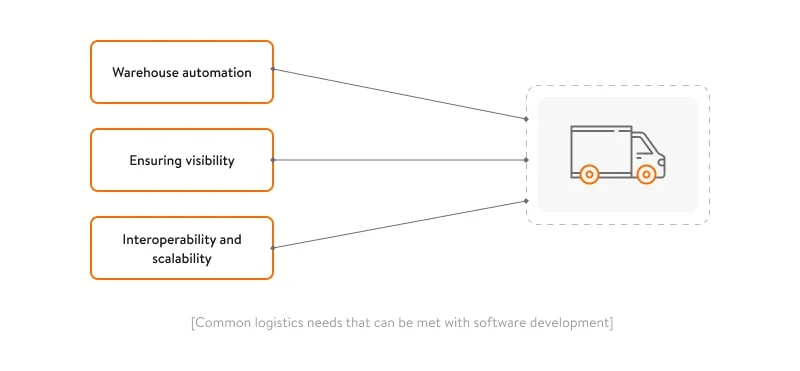
Read also: How to Use Technologies in Logistics Management System Development
Healthcare
When evaluating software development partners for your healthcare project, be attentive to a team’s familiarity with industry compliance requirements and experience working with sensitive data. Domain expertise is also important, but it can sometimes be overlooked, as security should be issue number one.
- Compliance with industry requirements. You must comply with requirements for working with protected health information (PHI) and follow the Health Insurance Portability and Accountability Act (HIPAA). Before you start developing custom healthcare software, make sure the team understands how to comply with all relevant laws, standards, and regulations. Ensure compliance by conducting an in-depth risk analysis, training the team on cybersecurity measures, enabling two-factor authentication, and creating an action plan to deal with potential long-term security risks.
- Data storage and transmission. Digitizing legacy handwritten systems and ensuring data transfer between them makes patients’ sensitive data especially vulnerable. When building infrastructure for your healthcare solution, pay special attention to the ways your data will be stored and managed. Make sure integrations you implement include a Health Level Seven (HL7) messages interface and ways for securely sharing data.
- A holistic approach to development. Apart from following security policies, a good healthcare solution should allow for real-time communication and meet the expectations of its end users. Make sure the solution a vendor suggests is comprehensive and user-friendly on the one hand and easily scalable on the other. Assess how the doctor–patient communication flow is envisioned within your app.
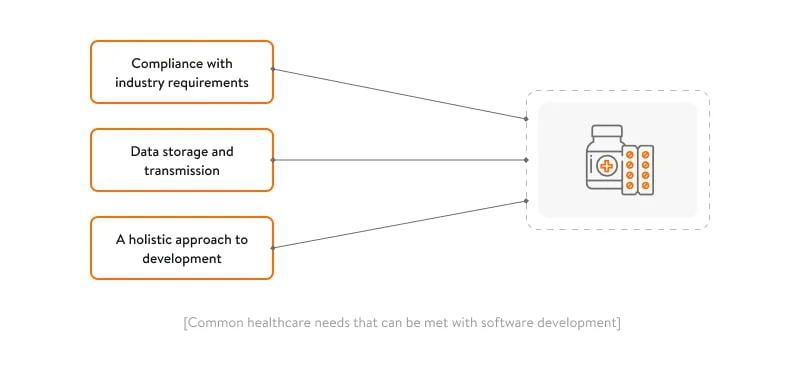
Communication
Whenever you’re building a messaging app, connecting your teams via a corporate portal, or implementing notifications into your existing software, you’re likely to consider addressing the four major needs of your business and its customers.
- Scalability is a common need that appears when developing communication software. As a rule, user growth is a goal that’s implied in your request to potential vendors. Providing an estimate for your product’s development starts with choosing the most appropriate architecture and providing a basis for potential integrations with third-party services like voice assistants and social media.
- Ability to handle high loads. Increasing the number of users requires a system that will remain stable during peak loads. In the communication domain, you would expect software providers to include hours of all-around performance testing in the project scope. Decide on how you’ll get insights about system errors and agree on ways to deal with them.
- Security. Keeping users safe while they’re online includes but is not limited to complying with the General Data Protection Regulation (GDPR) principles, providing secure messaging and end-to-end data encryption for voice and video calls, and using other methods to ensure data protection and privacy.
- Usability achieved through an easy and attractive interface is something that sophisticated end users of communication engines not only expect but take for granted. In order to address this requirement, assess the UI/UX expertise of your software outsourcing vendor and ask them to provide creative decisions based on user behavior patterns. We lent our expertise to create a bright and intuitive design that was part of an online communication channel developed for KPMG.
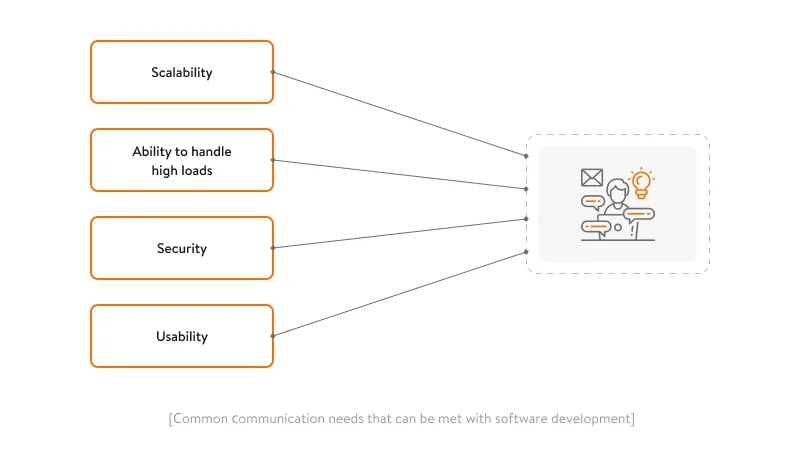
As you can see, the needs of each company within a specific domain differ, as do the criteria used to assess offers from potential outsourcing partners. A general recommendation would be to remain attentive to details and evaluate how flexible a service provider is in meeting your needs and how their domain expertise helps them suggest reasonable solutions for your specific case.
How to make the right choice
Carefully selecting potential vendors contributes to the success of your technological solution. In this guide, we collected some tips and tricks for evaluating software development partners. At the same time, the choice is yours. Here are the key takeaways of this guide:
- Evaluate how your business needs are met at each of the six stages of the software development vendor selection process.
- To measure if your requirements have been addressed, ask yourself questions about the solutions each IT service provider suggests in response to your needs.
- If your project involves several stakeholders, create a vendor list to come to a common understanding of the pros and cons of working with each vendor and make a collective decision.
- When evaluating potential vendors, don’t neglect criteria like vendor maturity, technological experience, and location. At the same time, what matters most are the domain expertise of a service provider and your specific software development needs.
- We recommend ramping up your team with subject matter experts to comply with industry requirements and increase the velocity of software development as well as the quality of your final product.
At Yalantis, we build custom software that allows businesses to meet their needs and work within their constraints. As a strategic partner, we help our clients digitally transform to improve their products, speed up service delivery, increase operational efficiency, and expand to new markets.
Our tech expertise includes cloud computing and DevOps, working with big data and analytics, and developing SaaS and IoT solutions. Over more than 13 years in the market, we have built dozens of software solutions for logistics, healthcare, real estate, telecommunications, and FinTech clients. Just recently, Yalantis has been ranked the best software development company in Ukraine according to The Manifest.
Rate this article
5/5.0
based on 1,123 reviews





